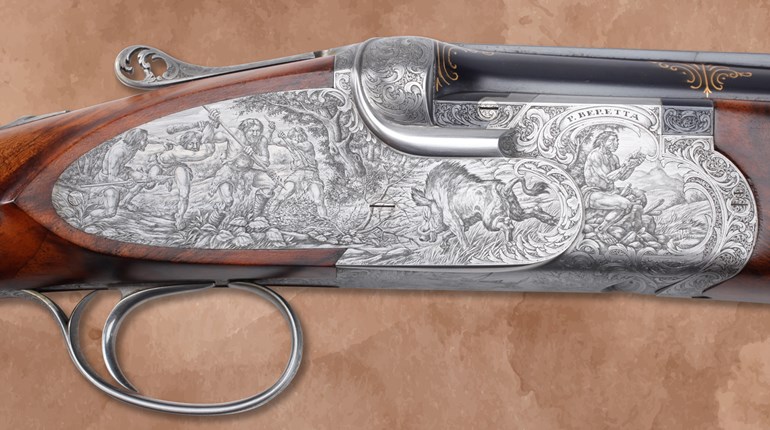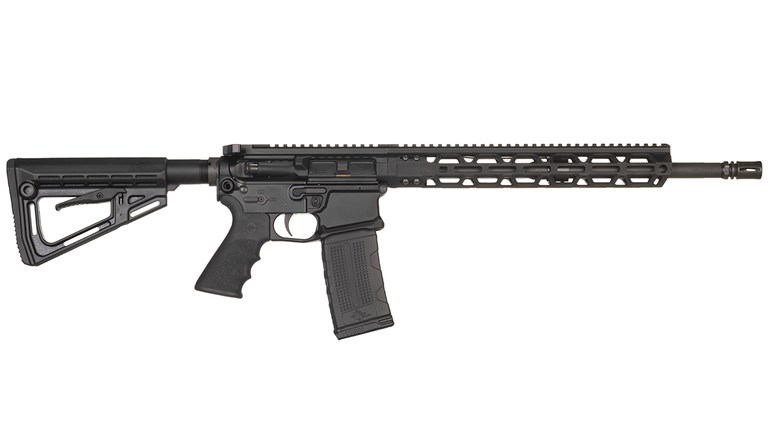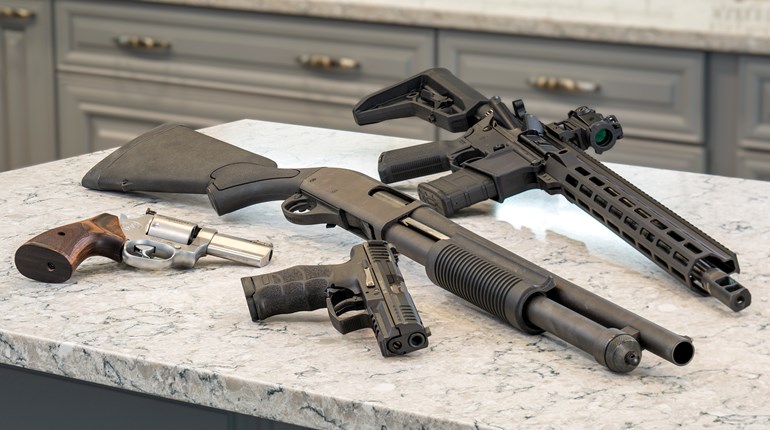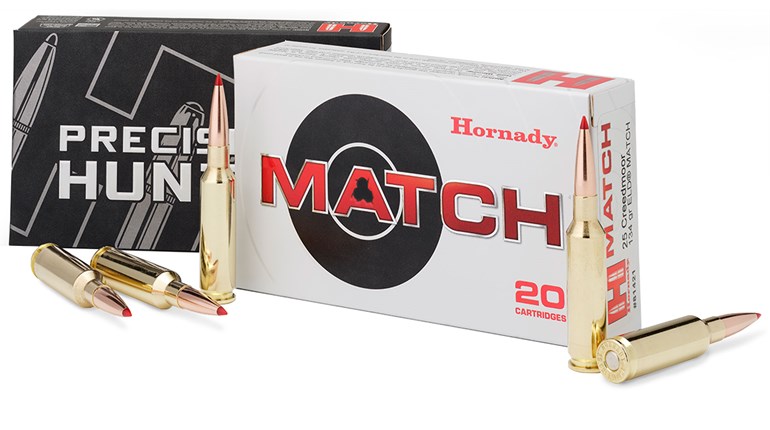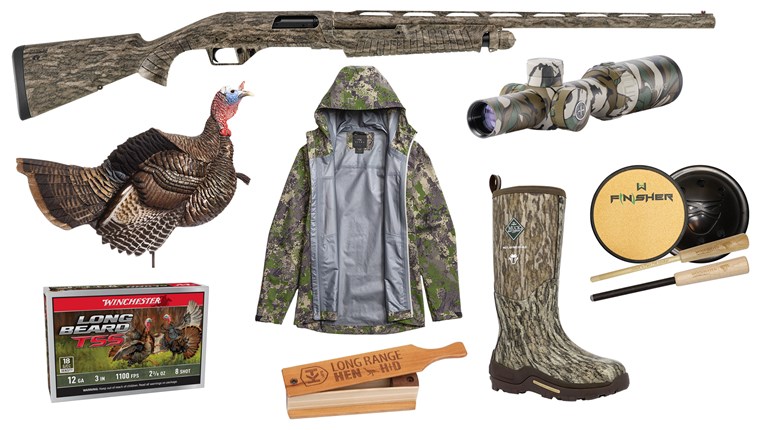
Quick thought exercise. What’s the first thing that comes to mind when you hear the words “Italian shotgun?” I’d wager most of us would think of a fine Silver Pigeon from Beretta, a gold-medal-winning Perazzi competition gun or the Benelli M4. As a general rule, “affordable” isn’t a descriptor attached to any of these. Even Beretta’s superlative 1301 semi-automatic shotgun runs well into the $1,500s. However, the company has recently lowered the barrier to entry in the Italian-shotgun market in a big way with its A300 Ultima Patrol shotgun.
How low, you might ask? It’s less than semi-automatic shotguns from Mossberg, Winchester and Savage, that’s how low. To find a more affordable semi-automatic shotgun would involve Turkish imports, and while there is absolutely nothing wrong with Turkish firearms, they aren’t Italian. Yes, I may be a tad biased. To be fair, though, the A300 Ultima Patrol isn’t exactly Italian—while it’s an Italian design, it’s made here in the U.S. So, it’s Italian-American, like me. Maybe that’s why I like it so much. However, there’s something to be said for Beretta’s literal 500-year history (in just a few years, the company will have 500 documented years in the firearm-making business). Lastly, the 1301 is pretty much the zenith of semi-automatic, defensive-shotgun design, and while the A300 Ultima Patrol is slightly different, the shared heritage lends significant gravitas to its pedigree. One doesn’t expect a car from Ferrari to be slow, and one doesn’t expect a firearm from Beretta to be deficient.

What are the differences between the 1301 and the A300? That’s a great question, and we reached out to the folks at Beretta for the answer. Dina Sanders, brand marketing manager, tactical for Beretta USA, explained, “The largest difference between the 1301 and the A300 Ultima Patrol is the use of the BLINK gas and bolt system in the 1301, this rotating head bolt system is faster, absorbs more recoil and has fewer parts and so is less likely to fail over time than the bolt system used in the A300 Patrol which uses an older bolt design. In addition the 1301 is made in Italy and the A300 family is made here in the U.S.”
A300 shotguns have been in Beretta’s sporting line for quite some time, so bringing a tactical version into that space made sense. Sanders mentioned, “We expanded the A300 line into the defensive space based on customer requests for an American-made, mid-price point gun to compete with other inertia-driven platforms. Beretta USA gathered feedback from customers of the 1301 and studied trends in the 3-gun space to deliver to customers an ultra-reliable, defensive shotgun with a suite of features serious shotgun users want. When building these guns in America, we are free to incorporate these changes without needing to sacrifice to import restrictions. We believe with the launch of the A300 Ultima Patrol, Beretta now has two amazing, feature-rich platforms at several price points for customers to choose between.”
While the two shotguns do have some differences (in addition to the operating systems, the A300 has a slightly longer barrel), they share quite a bit of their footprint as well. Both have ghost-ring sights, a rail for optics, M-Lok attachment points on the fore-end, QD sling attachment points and oversize controls. From an aesthetic standpoint, the 1301 has a more “finished” look for lack of a better term; however, aesthetics are in the eye of the beholder, and there are plenty who will view the cost-savings of the A300 as an incredibly attractive thing, indeed. The price difference, in excess of $400, will allow for lots of practice ammo, for one thing.
I want to put aside the price point and obvious comparison to Beretta’s other defensive shotgun for a moment, though. The A300 Ultima Patrol is a fantastic shotgun independent of both of these factors. The ergonomics are nothing short of amazing—the gun points extremely well, the areas where one grips the stock and fore-end are aggressively textured to firmly anchor it in the hand and M-Lok slots for lights or lasers are positioned where right- or left-handed shooters will be able to instinctively find them. Prefer a high hold with the support hand? Put your light in the top M-Lok slot on the magazine-support bracket. Not so high? Use the slot on the side of the fore-end itself. Heck, if you want to pretend it’s 2003 and you want a vertical fore-grip, there’s even a slot at the bottom-front of the fore-end for that. Even if you don’t want to add anything, it’s well-designed.

This thoughtful engineering carries over into the little things, too. While the A300 Ultima Patrol only comes with one choke tube (Improved Cylinder), it uses the Beretta Mobil Choke system which offers up a whole world of options should one wish to change constriction. Two separate spacers can change the length-of-pull to better fit the A300 to the shooter. There’s even a small piece of loop backing with adhesive that is custom-cut to match the left side of the receiver, so you can add a shell card of your choosing to keep more rounds on your A300 (and see our Shotgun column, page 36, for more on this topic). All controls are oversize, easy to actuate and intuitive; whether you’re taking the safety off as the sights come on target, releasing the bolt with the massive bolt release or pulling the bolt handle rearward to show clear, there’s no mistaking any of the controls.
Beretta lists the furniture as simply “synthetic,” and it’s here that you start to get a glimpse of some of the differences between the 1301 and the A300 Ultima Patrol. There’s certainly nothing wrong with the synthetic furniture of the A300, mind you; it’s just, well, “plasticky” for lack of a better word. This isn’t an artisanal polymer here, it’s just plain ol’ plastic. Again, for a utilitarian shotgun that’s supposed to serve for home defense under any condition, this is a plus rather than a minus—it’s not a gorgeous walnut that you’ll kick yourself for marring should the gun fall over and bounce off the ground. Besides, I’m wagering that this will be a big hit in the defensive community, and it wouldn’t surprise me in the least to see some of the Big Dogs (Magpul, looking at you here) come out with some upgraded components. In any case, though, what’s on the A300 is perfectly fine.

When it comes to heft, I honestly don’t know what kind of dark magic Beretta used on the A300 Ultima Patrol. The shotgun weighs 7 pounds, 2 ounces, but it felt significantly lighter than that. While I would never fire it that way, I found I could hold it with one hand for more than a few seconds, something I can’t say about my 590 or 870. Guess we know where the “Patrol” part of the name comes into play. Now, granted, this may mean a little more felt recoil when shooting slugs or 00 buckshot, but there are plenty of tips and tricks you can use to mitigate that when practicing. You can work on your stance and utilize the “push-pull” method to help with the recoil, but lightening a shotgun while still leaving it functional can be a wee bit more difficult.
Light weight and felt recoil aside, there’s another aspect to the A300 Ultima Patrol to address, though: the texture. While the aggressive nature of the pistol grip and fore-end will really help anchor the shotgun in your hand while shooting, should you opt for an extended range session or training class, it’s going to do a number on your hands. For anything more than a short practice session, it would be worthwhile to invest in a good pair of gloves to wear when shooting for longer periods. Again, this is by no means a knock on the A300; it’s a balancing act for any firearm to walk the fine line between too heavy to effectively carry for any length of time and too light to shoot more than a handful of rounds. Whether you’re talking about a miniscule semi-auto pistol, an ultralightweight .308 rifle or a shotgun, all have to obey the laws of physics. Be prepared, have the right gear and you will have a better experience all around.
On the range, no surprises were to be found, and that’s exactly what one expects of a Beretta shotgun. A mixture of birdshot, buckshot and slugs was tested in the A300 Ultima Patrol, with everything from light No. 8 birdshot to 3-inch 00 buckshot went through the paces. A handful of slugs were tested just to get an idea of what those were like in this lightweight shotgun (hint: ouch), but for everything that was tested, the A300 ran like a champ. Our Managing Editor, Digital, Kevin Creighton, also had a chance to run a different A300 Ultima Patrol at the shotgun’s launch, and he, too, was impressed with how the A300 ran, stating, “The shotgun made it easy to handle the recoil from the various loads we used for demonstration purposes at the event.”
One critical thing I like to test on any shotgun I review is the pattern. Since the A300 Ultima Patrol is intended for home defense, knowing how popular 00 buckshot will pattern at various distances such as one would be likely to find inside the home is absolutely critical. Yes, you can miss with a shotgun. Shotguns do need to be aimed, and you absolutely need to know the maximum distance where all—repeat, all—of the pellets will land inside a roughly bad-guy-size target. Given the improved cylinder choke tube installed in the A300, I found that Federal Personal Defense 00 buckshot (2 3/4-inch, 9 pellet) yielded a 3-inch pattern at 5 yards, 4.5-inch at 10 yards and 7.5-inch at 15 yards. At 20 yards, pellets were starting to exit the 15-inch wide target, so I switched to Hornady 300-grain FTX slugs, which gave a 2.5-inch group at 20 yards. Interestingly, though, while the 00 buckshot was dead center through the irons, the slugs were slightly high and right. Not a knock on the Beretta, just a note to test everything you’re going to use extensively.
Other than patterning a defensive shotgun, finding a load that it prefers is also critical. Now, I’m not about to wade into the debate opened up by my esteemed colleague Bryce Towsley over whether a semi-auto shotgun is preferable to a pump (I’m agnostic, which is a polite way of saying “far too chicken to stick my neck out on this area of contention”). However, I will note that it’s a great idea to test any semi-automatic firearm with a decent variety of defensive and practice ammunition. It used to be far more common that pretty much every semi-auto out there would have its secret likes and dislikes, but even now in this seeming golden age, it’s better to trust but verify. Before you stock up on a pallet of THUNDERSTICK500 home-defense 00 buckshot, make sure it cycles the action every single time. In the case of the A300 and the admittedly small amount of 12-gauge ammo I put through it, it worked without fail with everything that went in. In testing, just shy of 100 rounds of 00 buckshot and 75 rounds of various birdshot fed, fired and ejected without fail. I’ll bestow my highest compliment on the A300 Ultima Patrol: it was boring. It just plain worked.
What’s the bottom line on the Beretta A300 Ultima Patrol? Well, if you’re in the market for a semi-automatic shotgun for home defense, it’s an excellent choice. It’s the least-expensive way possible to get yourself a Beretta shotgun, at least new, that I can find (I’m certain someone out there can find one cheaper, and I’m sure we’ll hear about it when they do). The A300 works well, has superlative ergonomics, is easy to shoot and comfortable to carry for a day’s worth of training. Not bad for an Italian-American shotgun; not at all. I mean, from the time of the great Christopher Columbus, to the time of Enrico Fermi, right up to the present day, Italian-Americans have been pioneers in building and defending our nation. They are the salt of the earth, and one of the backbones of this country. The Beretta A300 Ultima Patrol carries on that legacy with aplomb.













